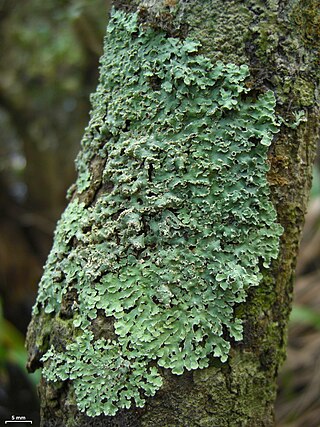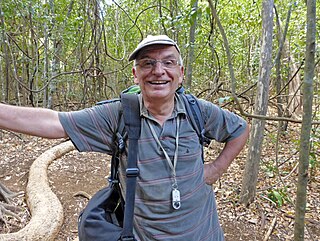
A lichen is a hybrid colony of algae or cyanobacteria living symbiotically among filaments of multiple fungi species, along with yeasts and bacteria embedded in the cortex or "skin", in a mutualistic relationship. Lichens are the lifeform that first brought the term symbiosis under biological context.

Parmelia is a genus of medium to large foliose (leafy) lichens. It has a global distribution, extending from the Arctic to the Antarctic continent but concentrated in temperate regions. There are about 40 species in Parmelia. In recent decades, the once large genus Parmelia has been divided into a number of smaller genera according to thallus morphology and phylogenetic relatedness.

Physcia is a genus of lichen-forming fungi in the family Physciaceae. The widely distributed genus contains about 80 species. The genus is cosmopolitan, and has been extensively studied in various regions in the past several decades, with significant biodiversity in South America identified as a central diversity hotspot. Physcia species are foliose, lobate lichens that grow with a loose to close appressed habit. Their upper surface is typically whitish, pale greenish, green-grey, or dark grey in colour. The thallus colour remains relatively unchanged when moistened. Physcia lichens typically grow on bark, on wood, or rock, although they have occasionally been recorded dwelling on man-made structures. They thrive in nutrient-rich environments and are expanding rapidly in urban areas of the United Kingdom previously affected by SO2 pollution.

Carolyn Wilson Harris was vice president of the Sullivant Moss Society during 1904–1905 and charge of the Lichen Department from 1901 to 1905. She also wrote many articles on various lichen genera and species. She was known for being an indefatigable worker, and did much to popularize the study of lichens; her help was always given freely and cheerfully to those who applied to her for assistance in their studies.

Edvard August Vainio was a Finnish lichenologist. His early works on the lichens of Lapland, his three-volume monograph on the lichen genus Cladonia, and, in particular, his study of the classification and form and structure of lichens in Brazil, made Vainio renowned internationally in the field of lichenology.
Thomas Hawkes Nash III is an American lichenologist. His research is about the biology and ecology of lichens, and the effects of air pollution on plants and lichens. He is known as an authority on the family Parmeliaceae. During his long career at the Arizona State University, he helped develop the lichen herbarium into a world-class collection with over 100,000 specimens representing more than 5000 species. In 2010, the year of his retirement, he was awarded the Acharius Medal for lifetime achievements in lichenology, and the following year had a Festschrift published in his honor.
Alan W. Archer is a mycologist and taxonomist. He is currently an honorary research associate at Royal Botanic Gardens Sydney. He uses chemotaxonomy as well as morphological features in taxonomy and to devise keys, most recently for the genus Pertusaria in the Australasia region.

Emmanuël Sérusiaux is a Belgian lichenologist. His career, spanning more than four decades, has combined both lichenology research and political aspects of nature conservation. He spent several periods working as a researcher at the National Fund for Scientific Research and the University of Liège, the latter in which he accepted a faculty position as professor and head of the Plant Taxonomy and Conservation Biology unit. Sérusiaux also served for three non-consecutive appointments as Deputy Chief of Staff in the Government of Wallonia. He retired from both his academic and political positions in 2019.
Klaus Kalb is a German lichenologist and an authority on tropical lichens. Born in Nuremberg, he studied at the University of Erlangen–Nuremberg before pursuing a career that significantly advanced the field of lichenology, particularly in Brazil. Kalb's work in São Paulo from 1978 to 1981 led to a collaboration with Brazilian lichenologist Marcelo Pinto Marcelli, which is considered a model for non-commercial benefit-sharing in taxonomic research. He later became an associate professor at the University of Regensburg and is known for editing the exsiccata series Lichenes Neotropici. Kalb's contributions to lichenology include over 120 scientific publications, the description of numerous new species, and the development of a substantial lichen collection. His work has been recognised through various honours, including four lichen genera and numerous species named after him, as well as a Festschrift published in 2007 to mark his retirement.

The following outline provides an overview of and topical guide to lichens.









